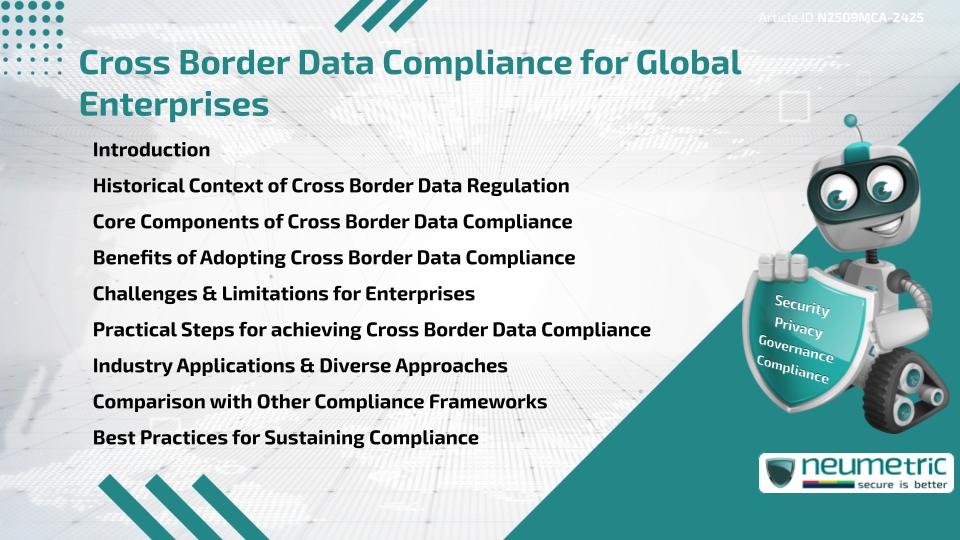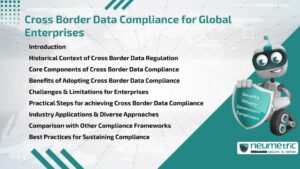Table of Contents
ToggleIntroduction
Cross Border Data Compliance is the practice of ensuring that Personal, Financial or Sensitive Information transferred across national boundaries complies with applicable laws & regulations. For global enterprises, this requirement is critical due to the rise of international operations, cloud adoption & digital services. Effective Cross Border Data Compliance ensures Regulatory alignment, reduces Penalties, enhances Data Protection & builds Trust with Clients & Regulators. It is an essential Framework for enterprises navigating global digital ecosystems.
Historical Context of Cross Border Data Regulation
The demand for regulating international Data Transfers grew as businesses expanded online in the late 20th century. Laws such as the European Union’s General Data Protection Regulation [GDPR] introduced strict rules around how data could be transferred outside the EU. Mechanisms like Standard Contractual Clauses [SCCs] & adequacy decisions shaped the foundation of Cross Border Data Compliance. Similarly, other regions such as the United States & Asia-Pacific developed data transfer agreements to safeguard citizens’ information, making this a truly global issue.
Core Components of Cross Border Data Compliance
Enterprises must address several components to achieve Compliance:
- Legal Understanding: Awareness of regulations in all jurisdictions involved.
- Transfer Mechanisms: Adoption of legal instruments like SCCs or binding corporate rules.
- Risk Assessments: Evaluating Risks associated with Data Transfers to third countries.
- Documentation & Transparency: Maintaining clear Records for Regulators & Stakeholders.
- Security Measures: Ensuring Encryption, Access Control & Monitoring of transferred data.
These elements together form the foundation of Cross Border Data Compliance.
Benefits of Adopting Cross Border Data Compliance
Global enterprises gain multiple benefits from implementing Compliance frameworks. They avoid costly fines & reputational harm while enhancing operational efficiency in handling data across regions. Compliance also builds stronger Trust with Customers who value Transparency & Accountability. Furthermore, enterprises that master Cross Border Data Compliance gain a competitive advantage in industries where secure international operations are a priority.
Challenges & Limitations for Enterprises
Despite the advantages, achieving Cross Border Data Compliance can be complex. Regulations often conflict across jurisdictions, leaving enterprises uncertain about the right approach. Smaller organisations may struggle with the high costs of Legal Consultations, Audits & Technological tools. Additionally, constantly evolving laws require ongoing adjustments, while limited data centre availability in certain countries adds logistical challenges.
Practical Steps for achieving Cross Border Data Compliance
Enterprises can follow structured steps to establish Compliance:
- Identify the jurisdictions where data is processed & transferred.
- Map data flows & classify sensitive categories.
- Review applicable laws & transfer requirements.
- Adopt legal mechanisms like SCCs or local contracts.
- Implement technical safeguards such as Encryption.
- Train staff to understand Cross Border Data Compliance obligations.
This roadmap ensures enterprises approach Compliance systematically & sustainably.
Industry Applications & Diverse Approaches
Different industries approach Compliance according to their Risk exposure. Financial institutions emphasise Compliance due to sensitive Financial records. Healthcare organisations prioritise patient Confidentiality & Health regulations. Technology companies handle vast amounts of User Data & must navigate global Privacy rules. While methods vary, all industries share a common goal: protecting data across borders in a legally compliant manner.
Comparison with Other Compliance Frameworks
Cross Border Data Compliance differs from frameworks like Cybersecurity management or operational Risk oversight. While those focus on protecting systems & operations, this Framework ensures that international transfers comply with Legal requirements. However, when combined, these approaches provide enterprises with both Security & Compliance, creating a holistic Governance strategy.
Best Practices for Sustaining Compliance
To maintain Compliance over time, enterprises should:
- Conduct regular Audits of international data flows.
- Stay updated on evolving Legal frameworks.
- Collaborate with Legal experts & regulators.
- Integrate Compliance Policies with broader Governance models.
- Build transparency with Customers about how their data is transferred & protected.
By following these practices, enterprises can sustain Cross Border Data Compliance effectively.
Conclusion
Cross Border Data Compliance is an essential Framework for global enterprises managing Sensitive Data in multiple jurisdictions. By combining legal awareness, technical safeguards & transparent practices, organisations can minimise Risks, protect Customers & strengthen their global presence.
Takeaways
- Cross Border Data Compliance ensures international transfers follow legal standards.
- Historical laws like GDPR shaped global Compliance practices.
- Core components include legal mechanisms, documentation & security.
- Benefits include reduced Risks, stronger Trust & Competitive advantage.
- Challenges involve jurisdictional conflicts, costs & evolving laws.
FAQ
What is Cross Border Data Compliance?
It is the practice of ensuring international Data Transfers comply with applicable national & regional laws.
Why is Cross Border Data Compliance important for global enterprises?
It protects organisations from fines, builds Trust & ensures the lawful handling of Sensitive Information.
What laws impact Cross Border Data Compliance?
Laws such as GDPR, SCCs & regional data localisation rules have significant influence worldwide.
What industries are most affected by Cross Border Data Compliance?
Finance, Healthcare & Technology are most affected due to handling Sensitive & Regulated data.
What are the key challenges in achieving Compliance?
Conflicting regulations, high costs, evolving laws & limited local infrastructure create major challenges.
How can enterprises implement Cross Border Data Compliance?
By mapping data flows, adopting Legal safeguards, implementing Encryption & training Employees.
How does Cross Border Data Compliance differ from Cybersecurity Compliance?
While Cybersecurity focuses on protection from Threats, Cross Border Data Compliance ensures legal alignment of international transfers.
Need help for Security, Privacy, Governance & VAPT?
Neumetric provides organisations the necessary help to achieve their Cybersecurity, Compliance, Governance, Privacy, Certifications & Pentesting needs.
Organisations & Businesses, specifically those which provide SaaS & AI Solutions in the Fintech, BFSI & other regulated sectors, usually need a Cybersecurity Partner for meeting & maintaining the ongoing Security & Privacy needs & requirements of their Enterprise Clients & Privacy conscious Customers.
SOC 2, ISO 27001, ISO 42001, NIST, HIPAA, HECVAT, EU GDPR are some of the Frameworks that are served by Fusion – a SaaS, multimodular, multitenant, centralised, automated, Cybersecurity & Compliance Management system.
Neumetric also provides Expert Services for technical security which covers VAPT for Web Applications, APIs, iOS & Android Mobile Apps, Security Testing for AWS & other Cloud Environments & Cloud Infrastructure & other similar scopes.
Reach out to us by Email or filling out the Contact Form…





